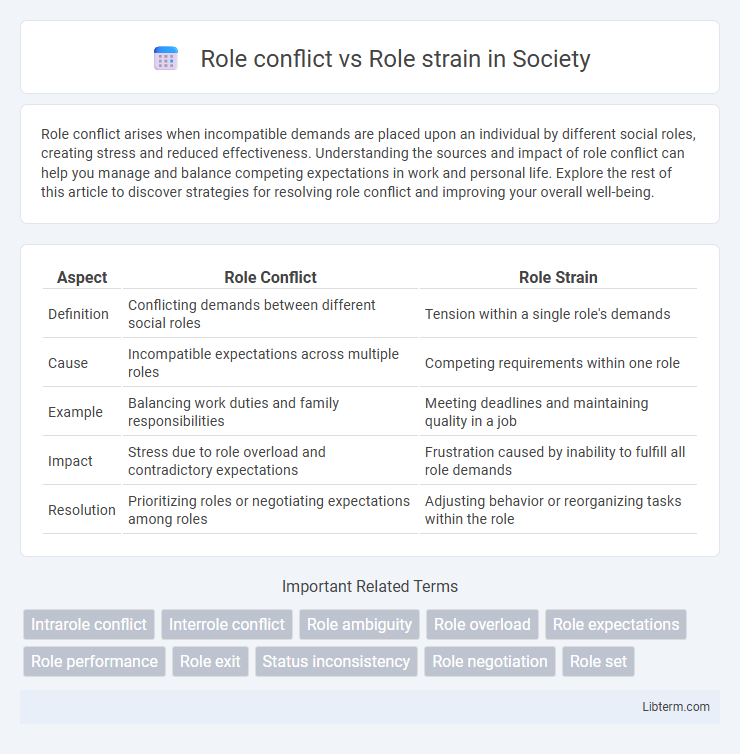Role conflict arises when incompatible demands are placed upon an individual by different social roles, creating stress and reduced effectiveness. Understanding the sources and impact of role conflict can help you manage and balance competing expectations in work and personal life. Explore the rest of this article to discover strategies for resolving role conflict and improving your overall well-being.
Table of Comparison
| Aspect | Role Conflict | Role Strain |
|---|---|---|
| Definition | Conflicting demands between different social roles | Tension within a single role's demands |
| Cause | Incompatible expectations across multiple roles | Competing requirements within one role |
| Example | Balancing work duties and family responsibilities | Meeting deadlines and maintaining quality in a job |
| Impact | Stress due to role overload and contradictory expectations | Frustration caused by inability to fulfill all role demands |
| Resolution | Prioritizing roles or negotiating expectations among roles | Adjusting behavior or reorganizing tasks within the role |
Understanding Role Conflict and Role Strain
Role conflict occurs when an individual faces incompatible demands from multiple social roles, causing tension between differing responsibilities, such as being both a parent and employee. Role strain arises when conflicting expectations exist within a single role, leading to difficulty meeting the demands of that specific position, like a teacher managing diverse student needs. Understanding role conflict and role strain helps in identifying sources of stress in social roles and improving strategies for effective role management.
Defining Role Conflict
Role conflict arises when an individual faces incompatible demands from multiple social roles simultaneously, causing tension and difficulty in fulfilling each role effectively. This occurs when expectations from different roles, such as employee and parent, clash, making it challenging to meet both sets of obligations. Understanding role conflict is essential in sociological studies because it highlights the pressure individuals experience in navigating diverse social responsibilities.
Defining Role Strain
Role strain occurs when an individual faces difficulty fulfilling the demands of a single social role, leading to stress and tension due to conflicting expectations within that role. It differs from role conflict, which involves incompatible demands from multiple roles. Understanding role strain highlights challenges in meeting role-specific responsibilities despite having only one role to navigate.
Key Differences Between Role Conflict and Role Strain
Role conflict occurs when individuals face incompatible demands from multiple social roles, such as balancing work responsibilities and family obligations simultaneously, leading to stress and tension. Role strain arises within a single role due to competing expectations or pressures, for example, a manager struggling to meet both team performance targets and employee satisfaction. The key difference lies in role conflict's cross-role contradiction versus role strain's intra-role difficulty, affecting how individuals manage and prioritize their social duties.
Causes of Role Conflict
Role conflict arises when incompatible demands stem from multiple social roles, such as being both a manager and a parent, leading to stress and decreased performance. The primary causes include contradictory expectations from different roles, time constraints that prevent fulfilling all role responsibilities, and value conflicts between personal and professional roles. Understanding these causes helps organizations design better role structures and support systems to minimize conflict and enhance overall well-being.
Causes of Role Strain
Role strain arises when an individual struggles to meet the demands of a single social role, often due to conflicting expectations, insufficient resources, or internal value clashes within that role. Causes of role strain include overload from excessive responsibilities, ambiguity in role expectations, and inadequate support from the social environment. This contrasts with role conflict, which involves tension between competing demands of different roles held simultaneously.
Impact of Role Conflict on Individuals and Groups
Role conflict arises when individuals face incompatible demands from different roles, leading to stress, decreased productivity, and emotional exhaustion. This tension negatively affects group dynamics by fostering misunderstandings, reducing cooperation, and increasing turnover rates. The resulting disruption undermines overall organizational effectiveness and individual well-being.
Effects of Role Strain in Daily Life
Role strain often leads to increased stress and decreased productivity as individuals struggle to meet the demands of a single role. This tension can cause emotional exhaustion, impair decision-making, and reduce overall well-being in daily activities. Chronic role strain may also contribute to social withdrawal and diminished satisfaction in personal and professional life.
Strategies to Manage Role Conflict and Role Strain
Strategies to manage role conflict include setting clear priorities, effective time management, and open communication to negotiate expectations among competing roles. Addressing role strain involves seeking social support, developing coping skills, and realistic goal-setting to reduce pressure from demanding role requirements. Both approaches emphasize flexibility and boundary-setting to balance responsibilities and maintain well-being.
Conclusion: Balancing Multiple Roles
Balancing multiple roles requires navigating the challenges of role conflict, where competing demands from different roles clash, and role strain, which arises from stress within a single role. Effective management of time, clear communication, and setting realistic expectations can reduce the negative impact of these pressures. Understanding the distinctions between role conflict and role strain enables individuals to develop tailored strategies for maintaining well-being while fulfilling diverse responsibilities.
Role conflict Infographic

 libterm.com
libterm.com